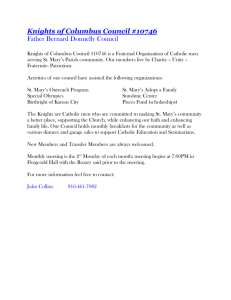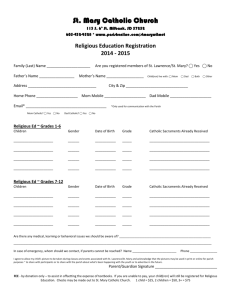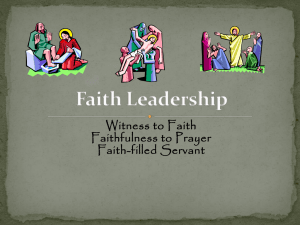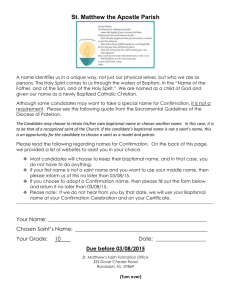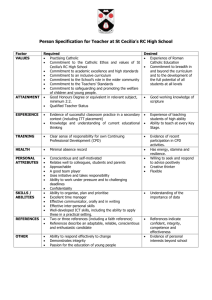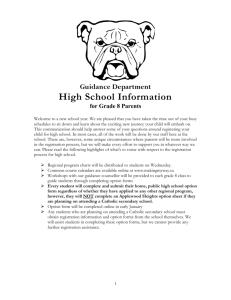Church: Yesterday and Today (0006)
advertisement
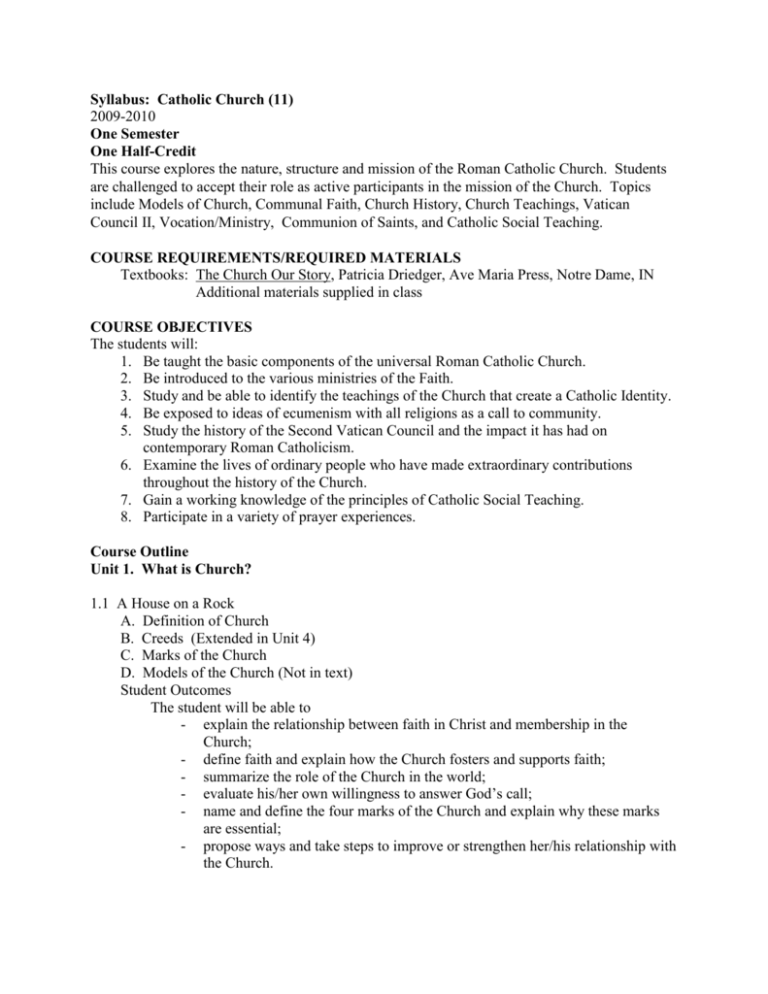
Syllabus: Catholic Church (11) 2009-2010 One Semester One Half-Credit This course explores the nature, structure and mission of the Roman Catholic Church. Students are challenged to accept their role as active participants in the mission of the Church. Topics include Models of Church, Communal Faith, Church History, Church Teachings, Vatican Council II, Vocation/Ministry, Communion of Saints, and Catholic Social Teaching. COURSE REQUIREMENTS/REQUIRED MATERIALS Textbooks: The Church Our Story, Patricia Driedger, Ave Maria Press, Notre Dame, IN Additional materials supplied in class COURSE OBJECTIVES The students will: 1. Be taught the basic components of the universal Roman Catholic Church. 2. Be introduced to the various ministries of the Faith. 3. Study and be able to identify the teachings of the Church that create a Catholic Identity. 4. Be exposed to ideas of ecumenism with all religions as a call to community. 5. Study the history of the Second Vatican Council and the impact it has had on contemporary Roman Catholicism. 6. Examine the lives of ordinary people who have made extraordinary contributions throughout the history of the Church. 7. Gain a working knowledge of the principles of Catholic Social Teaching. 8. Participate in a variety of prayer experiences. Course Outline Unit 1. What is Church? 1.1 A House on a Rock A. Definition of Church B. Creeds (Extended in Unit 4) C. Marks of the Church D. Models of the Church (Not in text) Student Outcomes The student will be able to - explain the relationship between faith in Christ and membership in the Church; - define faith and explain how the Church fosters and supports faith; - summarize the role of the Church in the world; - evaluate his/her own willingness to answer God’s call; - name and define the four marks of the Church and explain why these marks are essential; - propose ways and take steps to improve or strengthen her/his relationship with the Church. Unit 2. The Church is Mystery 2.1 Enduring and Changing A. Church as mystery B. Church as Bride of Christ C. What is permanent and unchanging in the Church, dogma (Extended in Unit 4) 2.2 Permanent and Unchanging A. Historical development of the Church B. Teachings not carrying the weight of dogma C. Ten Peak Moments In Church history(Not in text). Student Outcomes The student will be able to - explain why we say the Church is mystery; - illustrate some of the ways in which the mystery of the Church is reflected in the life of the Church; - identify the place of Church in Salvation History; - demonstrate why and how the Church is necessary for salvation - name and describe the three things in the Church which cannot and will not change; - describe the role of the magisterium in the Church; - demonstrate a knowledge of the progression of Church history and the time frame of key events within the Church; - identify the images or understandings of the nature of the Church that dominated different periods of Church history; - appreciate the way in which the Church of today is informed and shaped by the Church of other periods in history; - identify the images of the Church which he/she sees in operation in the local community. Unit Three: The Church is the People of God 3.1 Together as One A. Our roots in community B. Baptism as entrance into the community C. Communal nature of sin (Supplement text) D. Rights and responsibilities of membership – choosing not to exercise rights 3.2. Who is Catholic? A. The Gentile Question B. What is required to become and remain Catholic? C. Faith vs works – how do we show our love? D. Inclusion vs exclusion – apply to today (Supplement text) E. Vatican II Student Outcomes The student will be able to - understand the basic human and religious truth that human beings were not created to live in isolation; - name and describe the specific characteristics which define the People of God and the specific attitudes and behaviors which are a necessary part of our communal identity; - evaluate their own acceptance of Christian communal identity; - describe the requirements and implications of Church membership at various times in history; - describe the problem which the “lapsed” Christians presented for the Church and the Church’s response to them; - summarize the Council of Trent’s response to the Protestant reformers; - identify the changes in the Catholic aptitude toward non-Catholics Unit 4. The Church is Teacher 4.1 Creeds, Laws, Dogmas and Doctrines A. Dogma – the basic, unchangeable beliefs B. The role of Scripture C. The role of Tradition D. Infallibility and the Magesterium (Supplement text) 4.2 The Good News Proclaimed A. Historical spread of Christianity in Europe (Update: Ten Peak Moments?) B. Historical spread of Catholicism in North America (Supplement text?) Student Outcomes The student will be able to - explain how Church Dogma influences our everyday experiences; - define the term “revelation” and the role of Revelation in Christianity; - understand the similarities and differences between religious truth and scientific truth; - articulate the role of Scripture and Creed in Catholic teaching; - explain how “Tradition” is understood to contribute to our understanding of Jesus; - define dogma and heresy; - identify some of the challenges which Catholic dogma presents to the world today; - Unit 5. A. B. C. summarize some of the main events in the history of the Catholic Church in the United States. Ministry/Vocations (Not in text) Definition of ministry/vocation. Vows Vocation as a communal responsibility. Student Outcomes The student will be able to - explain the meaning of the vows of povery, chastity and obedience; - know the difference between diocesan and order priests; - identify types of religious orders; - know the definition of the charism of a religious order; - know the difference between a priest and a brother. Unit 6. The Church is Servant 6.1 The Social Doctrine of the Church A. Basic principles of Catholic Social Teaching 6.2 Responding to Those in Need A. Owning our history? B. Wealth and poverty. C. Just War? D. Application to current events (Not in text) (Update: Faithful Citizenship?) Student Outcomes The student will be able to - explain how service is integral to the Catholic faith; - tell why the Church’s responsibility to care for others always takes precedence over the state’s responsibility; - name some of the key Church documents on social issues and the teachings which they promulgated; - identify and demonstrate and understanding of three key principles of Christlike service - define principles of subsidiarity and solidarity; - understand the Church’s responsibility for owning its history, bad and good; - summarize the history of the Church’s commitment to the poor, including its “preferential option for the poor”; - understand the Christian attitude toward work; - recount the Church’s teachings on the family at various points in history and relate these to the prevailing attitude today; - identify the ways in which the shifts in the Church’s understanding of social issues since the late nineteenth century continue to affect the Church today; trace the history of the Catholic response to war; demonstrate an understanding of the “just war theory.” Unit 7. The Saints 7.1 Who are the saints? A. Relationship between values and virtues. B. Saints were/are ordinary people. Videos of lives of saints C. We are all called to be saints. D. The Communion of Saints. E. Mary as model saint. 7.2 Mary: Model and Mother of the Church A. Mary’s titles B. Classification of the Saints. (Not in text) C. Canonization Process. D. Saints as patrons. (Supplement text) Student Outcomes The student will be able to - define virtues and identify ways in which virtues have impacted her/his own life; - define holiness and cite examples of holiness within the Church today; - explain the role of the saints in the prayer life of the Catholic Church; - articulate Mary’s role in the Church; - explain the meaning of the Immaculate Conception and the Assumption of Mary; - outline the historical roots of the Catholic cult of the saints; - demonstrate a familiarity with a variety of different Catholic traditions honoring Mary; - explain Mary’s unique place in the communion of saints; - explain what it means to call Mary “Mediatrix.”


